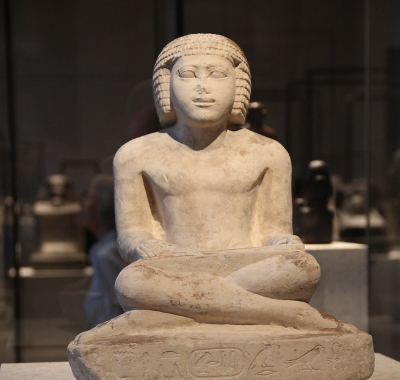A new study which examined skeletons has shed light on the increased risk of bone-related conditions for ancient Egyptian scribes.
Ancient Egyptian scribes suffered increased rates of osteoarthritis and joint conditions as a result of repetitive and stationery work, a paper published last month in the journal Scientific Reports claims.
The study centered on skeletons which were excavated in Abusir, a pyramid complex built during ancient Egyptian times.
The bulk of studies looking into the remains of ancient Egyptian scribes have focused on their statutes, titles, and methods of writing, but this recent study examined how the daily tasks scribes performed affected their skeletal structure. Specifically, the researchers wanted to understand whether the repetitive tasks and postures involved in scribal work had noticeable affects on their skeletons.
To create a control within the study, lower-status people from the third millennium BC, buried at Abusir, were analyzed alongside higher-profile scribes. This was because the former group did not undertake repetitive daily tasks.
The skeletons of ancient Egyptian scribes
The paper reports a statistically significant difference between the lower-status skeletons and scribes, specifically expressed in degenerative joint conditions.
The study also showed that master scribes experienced higher rates of degenerative abnormalities, most frequently in the cervical area of the spine. Researchers were able to determine that the position scribes wrote in—involving bending their necks downwards—damaged the bones in the neck that support the head.
Significant differences were noted in the osteoarthritic changes among the ancient Egyptian scribes but not in the control group, including obvious marks brought on by continuous strain on the neck and spine, attributed to working conditions.
A further discovery was the unusually high occurrence of osteoarthritis among scribes in the temporomandibular joint (TMJ). This most probably arose from the unusual tasks such as biting and chewing involved with assembling pens.
The paper also highlights notable osteoarthritis changes in the shoulder and upper limb regions of the scribes, particularly bearing strain on the joints and muscle attachment sites connected to writing tasks. These discoveries show us the effects of seemingly menial, everyday tasks on the skeleton, bringing to light the overlooked challenges of scribal work.
The term “scribes” in relation to ancient Egypt in the third millennium BC refers to men who held a wide range of administrative positions or functions. These individuals enjoyed a privileged position in society at that time since only around one percent of the population would have been literate and capable.



